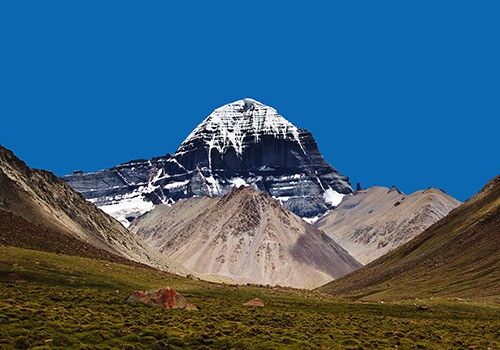The Mystical Mountain: Kailash Parvat
As a spiritual enthusiast, I am always excited to discover new mysteries within this domain. Not too long ago, I stumbled upon an interesting video about Kailash Parvat. It is a sacred mountain deeply steeped in the pages of the Hindu Vedas, Mahabharata, Shiva Purana, Ramayana, and Rig Veda. My curiosity led me to explore the various mysteries of Kailash Parvat.
Standing tall at 6,718 meters, Mount Kailash is located in the Gangdise Mountain range of Tibet. It is not just a geographical marvel but a spiritual epicenter; it is situated near the source of several of Asia's major rivers, including the Indus, Brahmaputra, Karnali, and Sutlej. To add to its mystique, Kailash is approximately 6,666 kilometers from the North Pole and double that distance from the South Pole. Nestled within China's boundary, the mountain is close to the borders of Nepal and India.
Kailash Parvat holds significance mainly for Hindus, Buddhists, Bons, and Jains. Hindus believe that Lord Shiva, the supreme god, meditates perpetually on this mountain. At the same time, Tibetan Buddhists associate the mountain with Buddha Demchok, representing supreme bliss. Jains believe it to be the place where Rishabhadeva attained liberation (moksha) after meditating for an extended period. In ancient tales, this mountain's four faces are believed to be crafted from precious materials like crystal, ruby, gold, and lapis lazuli. The rhythmic beats of a damaru and the resonating chants of "Om" echo within Kailash Parvat and create a cosmic atmosphere. During the winter, heavy snowfall forms the sacred Hindu symbol 'Om' (ॐ) on the mountain, adding to the place's spiritual significance.
Kailash Parvat is considered the "Center of the Universe" and the source of spiritual energy. Hindu pilgrims circumambulate (parikrama) the mountain, a ritual known as the Kailash Yatra, believing it purifies the soul and erases the sins of a lifetime. Many Buddhists also undertake the challenging pilgrimage to Kailash, known as Kora, circumambulating it as a sacred ritual to attain enlightenment.
Over the years, many adventurers have attempted to conquer Kailash Parvat, but there are no documented successful climbs. It remains an unclimbed peak, not due to its inaccessibility but because of its revered status. Climbing the mountain is discouraged to show respect for its sacredness. In Hindu legends, there's a story of Yudhistir successfully climbing after the Mahabharata. In contrast, in Tibetan mythology, the monk Milarepa's achievement is celebrated. Kailash Parvat is no ordinary mountain; it represents humanity's deep longing to connect with the divine. It's believed to possess a powerful, mysterious energy that transcends beyond our understanding.
In 1999, a Russian ophthalmologist, Dr. Ernst Muldashev, and his team made an astonishing claim that Kailash Parvat might be a massive man-made pyramid from ancient times. Dr. Muldashev suggested that smaller pyramids surrounded the main structure, possibly linked to paranormal energies. This intriguing hypothesis implies that ancient civilizations possessed knowledge of subtle energies, which they harnessed to build these remarkable structures.
The allure of Kailash Parvat motivated China's scientific community to investigate more on the mountain. However, their efforts faced formidable weather challenges. In 2015, NASA's advanced technology was used, which generated satellite images resembling a figure in meditation similar to Lord Shiva.
Kailash Parvat's mysteries don't stop there. It is rumored to be in constant motion, often confusing climbers and leading them astray. However, the fortunate few who reach a place known as Charansparsh (CSP) on the North face of Kailash report extraordinary experiences- strange lights, vivid dreams, and a deep sense of spirituality that exceeds typical adventures. Many experience emptiness, tranquility, immense peace, or even shed tears. Some pilgrims have also shared anecdotes of accelerated aging, with hair and nails growing within a day, which usually takes two weeks.
Despite strict rules prohibiting aerial passage over the summit and climbing activities in recent years, the lakes at its base - Mansarovar and Rakshas Tal – are still accessible. Although they are in proximity, Mansarovar Lake and Rakshas Tal are pretty different.
Mansarovar Lake, situated south of Mount Kailash, is revered in Hinduism and Buddhism as one of the most sacred and pure bodies of water. Pilgrims undertake ritual baths in its crystal-clear and tranquil waters to cleanse their souls, seek spiritual purification, and meditate by its shores for profound enlightenment. In contrast, Rakshas Tal is a smaller lake with deep blue and occasionally greenish salty waters in the west of Mount Kailash. It is often considered cursed with negative energies. Some believe it contains poisonous gasses that make it uninhabitable for humans and animals. These contrasting lakes teach us the delicate balance between good and evil in the natural world, a reminder that heaven and hell coexist closely on Earth.
In conclusion, Mount Kailash, an unclimbed Tibetan mountain, holds deep spiritual significance for various faiths. Its unexplained phenomena, enigmatic origins, and the contrasting Mansarovar Lake and Rakshas Tal have sparked curiosity about hidden secrets, including the possibility of an alien city or mystical caves inside the mountain. Some even believe it to be the mythical "Sworga lok" or Lord Shiva's abode. As we stand at the crossroads of curiosity, we eagerly await time's revelation of its hidden truths. Mount Kailash remains a timeless symbol of humanity's quest for spiritual understanding and a connection with the mysteries of the universe.
